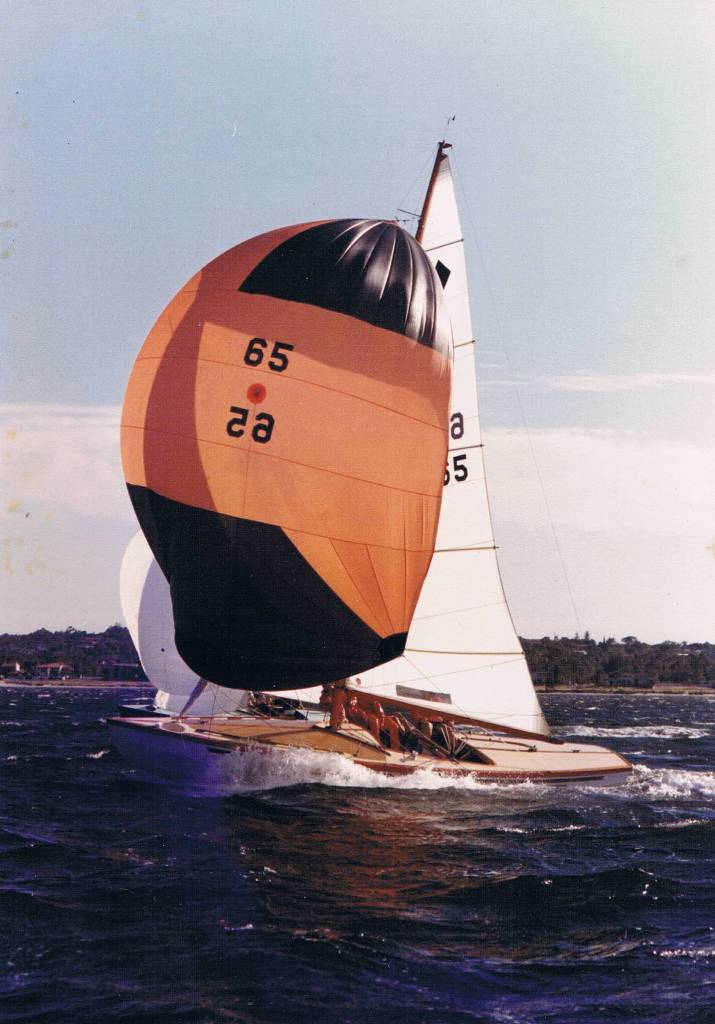January 27 - February 2, 2013: Issue 95
Walter ‘Wal’ Wardle
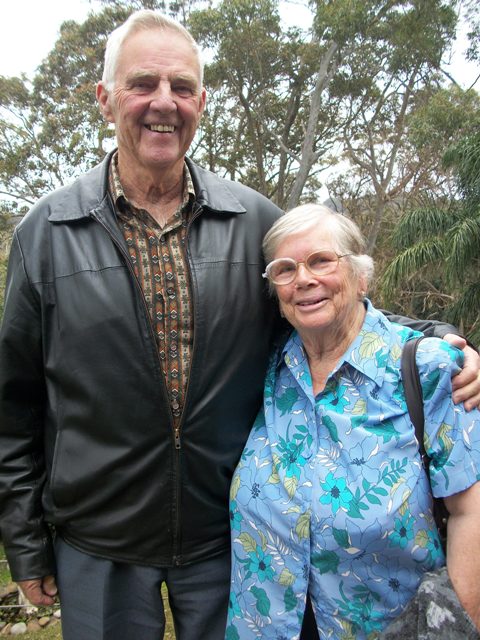 The skills of
sailing and ‘tuning’ a boat over many seasons so she flies and moves to the
slightest touch are something that come with experience and honing of your own
skills. A teacher of History and sailing, who also in his own sailing history
can communicate a lot of Pittwater’s sailing history, is Walter ‘Wal’ Wardle.
Open, warm hearted and generous with his time, still volunteering to help at
Sailability in Toronto on Lake Macquarie, who knows many a Pittwater yacht and
puts them together with the person who owns them, who signs off his emails
‘over’ as though we’re at sea and talking via radios, and who took his students
out of the stifling Summer classrooms to build medieval sandcastles on Avalon
Beach, is Mr Wal Wardle; a Pittwater asset !
The skills of
sailing and ‘tuning’ a boat over many seasons so she flies and moves to the
slightest touch are something that come with experience and honing of your own
skills. A teacher of History and sailing, who also in his own sailing history
can communicate a lot of Pittwater’s sailing history, is Walter ‘Wal’ Wardle.
Open, warm hearted and generous with his time, still volunteering to help at
Sailability in Toronto on Lake Macquarie, who knows many a Pittwater yacht and
puts them together with the person who owns them, who signs off his emails
‘over’ as though we’re at sea and talking via radios, and who took his students
out of the stifling Summer classrooms to build medieval sandcastles on Avalon
Beach, is Mr Wal Wardle; a Pittwater asset !
I started sailing at Prince Alfred with Harry Antill in 1963-4 season, on his diamond class yacht “Careel”. I joined the RPAYC in 1967 and was Commodore 1992 through 1994 having joined the committee in 1983. In those days we rotated through the Committee to give everybody experience as Chairman of Race , Boat Shed and Works and Membership, By the time you got to Commodore you knew all about each committee in the club and how it works. I think I may have been the last to do that.
What did you think of the new ‘Moon room’?
We have seen it and it looks very good.
What was the club like in 1967?
Very good. It was very very involved in racing. There was also a movement from racing to cruising and this started in the time I was Commodore. The club, traditionally, its main function had been to provide racing, yacht racing. It was at a time when we were also losing membership a little bit so we welcomed new activities, like the gym for example, that type of thing. And to try and open up the club to people who weren’t necessarily out and out sailors too.
What do you remember most as the highlight of your term as Commodore?
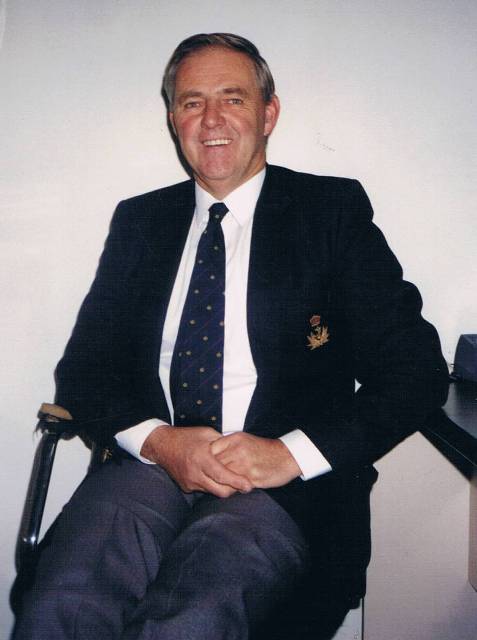 Two things stand
out in particular; one was the granting to Jack Gale of Life
Membership. The other was the admittance of ladies as members. I can
remember a period when what I used to call the ‘Blue Jacket Brigade’ which used
to think that ‘we’ve existed for 120 odd years, we don’t need the ladies’. I
have a wife and three daughters so I was very aware of the fact that none of my
kids or family could ever join the yacht club. Also I felt that it was
appropriate that women be allowed to join and I did understand that it was a big
change. But if we hadn’t done that, who knows, we might have ended up with court
orders.
Two things stand
out in particular; one was the granting to Jack Gale of Life
Membership. The other was the admittance of ladies as members. I can
remember a period when what I used to call the ‘Blue Jacket Brigade’ which used
to think that ‘we’ve existed for 120 odd years, we don’t need the ladies’. I
have a wife and three daughters so I was very aware of the fact that none of my
kids or family could ever join the yacht club. Also I felt that it was
appropriate that women be allowed to join and I did understand that it was a big
change. But if we hadn’t done that, who knows, we might have ended up with court
orders.
And you wouldn’t have a Silver Olympic champion as a member…
That’s right. Or a Gold Paralympics champion as a member. Yes, I’m very happy about that. I was involved quite a bit with the Sailability in the early days. With Alan Jones. He actually started it at BYRA about 1995; Prince Alfred provided storage facilities for the 2.4s and really got it going initially. But now they’ve got their own quarters over at Rowland Reserve. I’m hoping they remember they got their initial start at the Alfred.
You were a teacher, what was your subject?
History. Initially I trained as a Primary School teacher at Bathurst Teachers College. This is where Freda and I met. I was one of the few teachers who experienced the lot: primary school, a one teacher school in the bush, teaching infants, and one of the proudest things I can remember is teaching kids to read. Now that’s going to effect their whole lives. Later on in the end, at High School, you’re going to affect them not be reading but by encouraging them to think and to question.
I did enjoy teaching at all levels, One of the things that helped me a lot at Pittwater was that so many kids sailed. I remember I had one, Year 11 Class, and we’d get into class on a Monday morning, first period, and Jack’s son Geoff would say “Oh, wasn’t that a beautiful breeze on Saturday Sir?” ; so we’d talk sailing for 10 minutes !
That helped me with the kids; we sort of bonded. The kids in the class who weren’t into sailing at the start of the year, by the end of the year they were almost all into it; About two of them weren’t of the 24 kids. I think about 8 or 9 of them picked it as a sport; they thought ‘we’ve got to be part of this’.
When did you start at Pittwater?
When Pittwater High School opened in 1963. So it is it’s 50th year in 2012. We dropped off a model of Kalori for this; it’s in the Library. I was appointed to P.H.S in its first year. I was still doing my degree then; mainly because there’s more money as a salary when you do the degree. You did two years, three years or four years training and that was also reflected in the scale of your income; not whether you’re a good teacher, or just your years of experience.
Where did you do your degree?
I did the first bit of it at Sydney (University of Sydney) and then the rest of it at New England through the Correspondence school. We’d go up there in September for a week and meet our tutors and that worked out very well; you were also working at school, preparing lessons at night and doing the study. It was a busy time.
How did the Kalori come about ? What was the first conversation that eventuated in a yacht being built in the canteen at Pittwater High School?
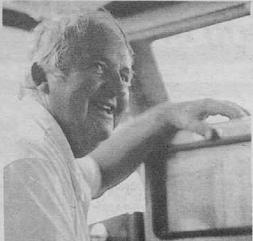 It’d
have to be the 1968 Sydney-Hobart Yacht Race. At the time, Harold
Vaughan, whom I used to sail with on his Diamond which was called
‘Saltash’. We were halfway across Bass Strait in the yacht
“Shimaal”, in quite a storm, and Harold said, “Well, how
would you like to build a Diamond at the school?”.
It’d
have to be the 1968 Sydney-Hobart Yacht Race. At the time, Harold
Vaughan, whom I used to sail with on his Diamond which was called
‘Saltash’. We were halfway across Bass Strait in the yacht
“Shimaal”, in quite a storm, and Harold said, “Well, how
would you like to build a Diamond at the school?”.
I said “Oh, that’d be great Harold.” Then forgot about it.
I thought maybe, with the storm and all, it’d got to him. But Harold at the time was President of the Australian Diamond Association. It was promoted by the English magazine ‘Yachting World’. The Yachting World Diamond Class was designed by Jack Holt with the idea being that you could build it yourself. So I just forgot all about it until Harold rang me up one evening about May the next year (1969) and said “Well, I’ve got all the materials; when are we going to start?”. So we started in June 1969.
The school was all for it?
Oh yes. We had to go and talk to the P&C Association. The headmaster Jim Gorrell, he lived in Bayview, and Jim was all for it; I don’t think he understood what he was in for, but it was built there by volunteer parents, probably would have been 10 parents, and we had a group that would come in two nights a week; I’m guessing it was the Tuesday night and Thursday night, and they would work through from 6 or 7 o’clock until whatever time the job took.
I remember one occasion when we had the by-laws inspector from the Council come around; he’d had a complaint about noise. What was happening was we were riveting and you know Bang … BANG… BANNG!
I explained to him what we were doing, because we
had glue setting, riveting etc. and he said “I’ll come back in half an
hour.”
He went away, came back and by then we’d finished, and then he ordered
us to stop. What a decent chap! He understood, had the spirit,
exactly.
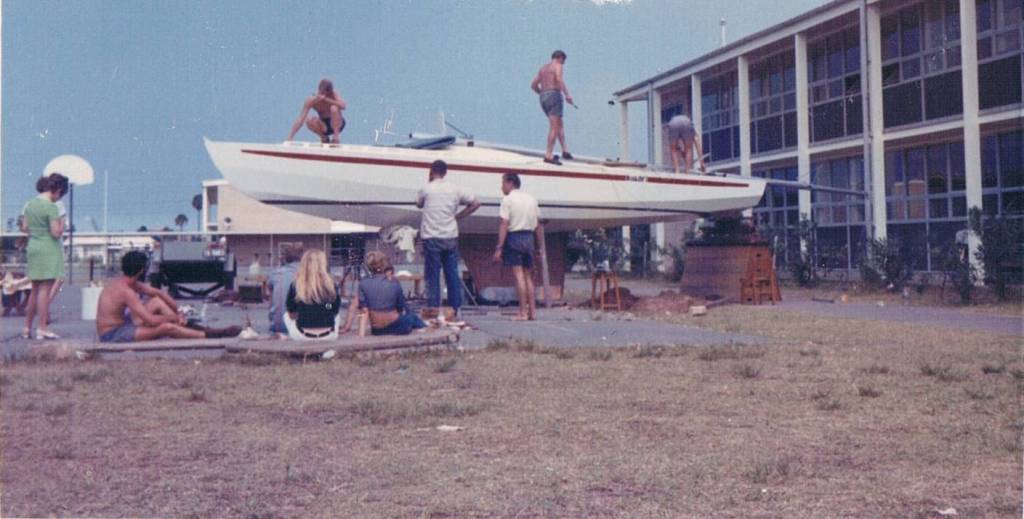
Did the students help build her as well?
Oh yes. They worked odd afternoons except Sports Days. There wasn’t a regular pattern with that. We’d just stay after school. I used to co-ordinate with the different parents on the Tuesday and Thursday evenings. Then on two or three afternoons a few of the kids would stay and do a little bit and then go home. If we ran a bit late we’d go in on the weekends and try and catch up.
Why did you choose the name ‘Kalori’; Alan told us it meant ‘Message Stick’, where did that idea spring from?
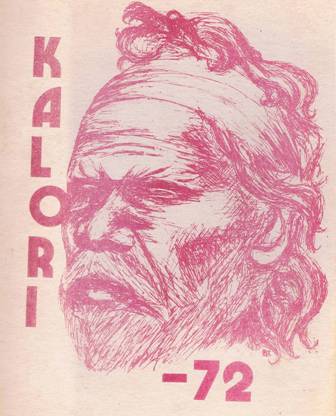 It’s
a corruption of an aboriginal word; I can’t remember what the original word was,
but ‘message stick’ we thought was a good word because we were going to use it
as a training boat.
It’s
a corruption of an aboriginal word; I can’t remember what the original word was,
but ‘message stick’ we thought was a good word because we were going to use it
as a training boat.
Message sticks were also traditionally used or given to someone who was going into another ‘country’ as a passport, passing between the different tribes; in this way it parallels sailing the different parts of the oceans as well; it translates across all those areas.
The word ‘Kalori’ was in the school anyway; it was the name for the yearbooks and magazines. Then they had one called ‘Nunana’ Kalori which was a pamphlet; a small edition. This one here, from 1972; with some pictures of Kalori. The yachting Diamond Association heard we were building a boat and they asked us would it be ready to display at the Boat Show, which was about six weeks off at the end of July, so instead of not giving them anything we did a scale model. I think it was one sixth to scale. That number, on the sail there, was never Kalori’s number, the chap who made the sails for it, Jack McKellar, he only died recently, so he used the number off his boat; I think 396. Kalori, when she came out, her number was 702, and then it became 122.
How long did it take to build her?
We started in June 1969 and launched her on March the 9th the following year, 1970. With the school Xmas holidays there would be a big break; so it took about six-seven months.
Where was she launched?
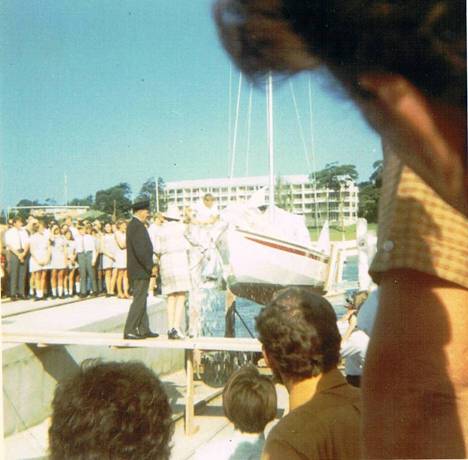 She
was launched at Prince Alfred, at the slipway by Lady
Cutler. When it was launched, it was about three o’clock in the
afternoon, March the 9th; it was the tradition with launching yachts that you
launched quickly. The cradle ran down the slipway, no braking at all, with the
crew on board. The skipper was Barry Byerley. Philip Frost was another member.
Into the water and off they went sailing and had its first collision in five
minutes. It was only minor and not caused by the crew but by a spectator craft,
and I thought, ‘Well thank goodness, we needn’t worry now; its had its first
ding;
She
was launched at Prince Alfred, at the slipway by Lady
Cutler. When it was launched, it was about three o’clock in the
afternoon, March the 9th; it was the tradition with launching yachts that you
launched quickly. The cradle ran down the slipway, no braking at all, with the
crew on board. The skipper was Barry Byerley. Philip Frost was another member.
Into the water and off they went sailing and had its first collision in five
minutes. It was only minor and not caused by the crew but by a spectator craft,
and I thought, ‘Well thank goodness, we needn’t worry now; its had its first
ding;
So sailing became part of the curriculum at Pittwater?
It already was. We introduced it in the Summer of ’63/64; as soon as the school returned in 1964. The chap who helped a lot was Zachary Stolznow, to get it established. He had a boy at the school, he had a restaurant too at French’s forest.
Can you remember Michael Jeffries or Campbell Knox?
Yes. They were very good sailors. Michael was a very good helmsman. His dad Brian built a Diamond called ‘Lucy Anne’ which was the first name of Michael’s mother. Michael was a very very good helmsman, he was … maybe the third Skipper. Another early skipper was Hendrik, Martin Visser‘s son, he was very good too, they both did very well at the State and Australian level.
You put her into the State Championships?
Yes straight away, in 1970. We also towed it to Melbourne. Brisbane and Hobart for the Nationals held each year. I can remember Melbourne and the presentation; they all came dressed up in dinner suits but they were wearing sailing shoes that looked like sandshoes. They made a grand entry after everyone had settled; and we all had a good laugh; sailing shoes with dinner suits! There was Hendrik and Roy Baker.
How many Championships did she win?
I don’t think it won a championship; mainly seconds and thirds. I know later on, when I owned a boat I won some, and they were seconds and thirds in the same series (Diamonds). In fact, I can remember having not incidents but close encounters with Kalori when Michael Jeffries was sailing her. I think in one Melbourne there was one decision against them.
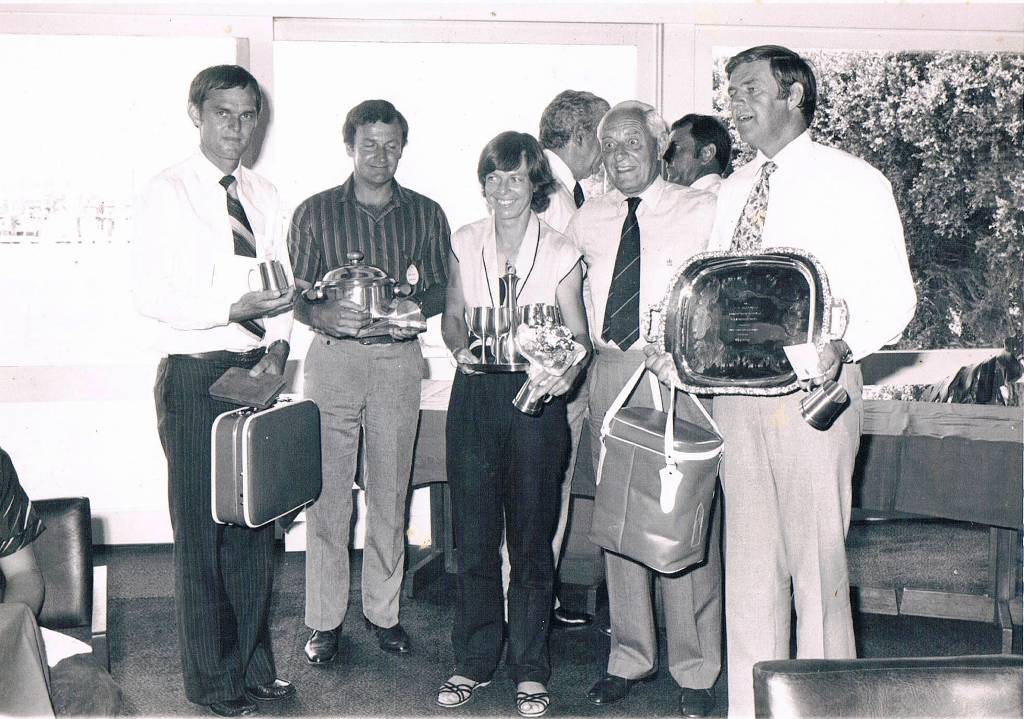
left to right: Bill Henshall, Cmdr. Royal Melbounre Yacht Club, George Winter, Sandy Ferguson, and Wally Wardle
There’s a few stories of the Kalori having problems sticking to the course and sailing rules; too much Pittwater freedom in them?
Yes ! (laughs).
How long were you at the school?
I left there at the beginning of 1974; that was one of the things I missed a lot, the involvement with Kalori.
Where did you move to?
I went to Barrenjoey High School as History Master. I certainly missed the school sailing. I went there in ’74 when it opened and retired in 1989, so fifteen years.
So Barrenjoey seemed to take on surfing as a sport, with the ocean on the front door;
What happened most frequently was if there was good surf up some kids would be late to school. They also used the beach; when I was teaching Year 9 kids we’d go down to the beach and build Medieval sandcastles; and that was a competition. The kids loved it. We’d get the headmaster down to judge. I’ve got some photos of that at home…
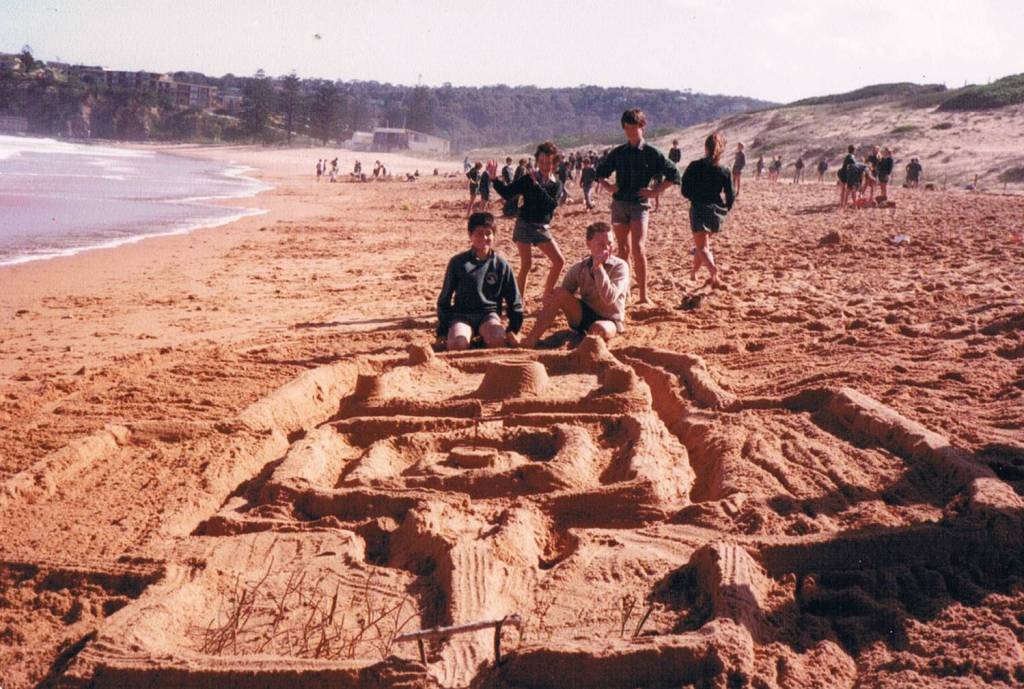
I was only 55 when I retired and started up a one man one boat Sailing school on Pittwater called ‘Sailwell’ which I finished in about 2005. We used to have brochures that said ‘Sail Well with Sailwell’. We started out with an Adams 31 in 1993. Freda’s a social sailor, she steers very well. When we’d go up to a mooring I’d go to grab it and Freda steers straight to it.
Did you teach in the area too Freda?
Freda; I was at Bilgola Plateau. It’s an excellent school. Wal: I was the first President of the P&C Association there. I was teaching there in 1965 and until 1980, then Deputy of Infants at Nth Narrabeen till 1987 then I returned to Bilgola Plateau and retired in 1995.
Wal: The first P and C Meeting was held at Avalon school because they were still building Bilgola, we’d only been in the district six months, and a near neighbour called for nominations for chairperson, called out my name, and the Inspector who was there said “Yes, Wal, you do it.”
There were no other nominations so I ended up doing it; it was the best thing that ever happened because we got to meet everybody very quickly; it helped us settle into the community. These were the days before there was water on too; we had tanks when we had the house built; two big tanks at the back.
How long was “Sailwell” on Pittwater?
About 12 years till 2005. I still kept my qualifications; I pay the annual fee, so I can help people like Sailability and still be accredited, but I only do work with volunteers now. I don’t charge anyone. Every now and then they give me a bottle of Port.
You were in Sailability at the beginning, helping Alan Jones?
Alan started it and I jumped in to help him. It was very good. We made a lot of friends there. You know that old TV show, ‘Dad’s Army’, as the volunteers were fairly elderly, so we used to call them and ourselves ‘Dad’s Army’. Another chap you could probably talk to is John Gordon regarding Sailability and sail training at BYRA on Pittwater. I got to know him through Sailability; he was what we called the ‘on shore coach’, and I was the ‘on water’ coach.
When you were training people as part of “Sailwell”, did you have a Program that you developed to help people move from beginners to experienced sailors?
Oh yes; I’ll send you a copy of that. It’s somewhere. The program was published as The National Yacht Cruising Scheme (TL4) by Yachting Australia. Yachting Australia also published the TL3 the powerboat scheme. TL4 goes from an Introduction to Sailing right up to Ocean Yacht Master. All the various levels are included, not only to learn and be instructed but also to be an Instructor. I did all my teaching using these programmes and adapted them to suit the individual needs of my customers.
I was also Chairman of the N.S.W. Yachting Association Training Committee from 1995-96 for about ten years. In 2006 they made me a Life Member; of Yachting N.S.W. I was embarrassed because I was still on the Committee then for N.S.W’s and I was at the meeting where they passed this resolution…(to make Wal a Life Member)
Did you vote for yourself?
No. (laughs) Not a good idea. No, I was very fortunate we had such support. I felt the people on that Training Committee were the best and the backbone of Sail Training in the State.; We all worked well together; they had the knowledge and the skills and the background; Don Gillies was a former military officer; he knew all about training, John Gordon; he also knew all about training disabled people; he did charters and trained some of the Australian Moth champions. We had people like that; there was girl from Gosford; Jane Humphris, she rang me up and asked me “What does the training committee do?’ I said “You better come down and find out. Jane ended up starting up her own powerboat school up there at Gosford. Lovely girl.
If someone called you up when you ran 'Sailwell' and said ‘I’m a novice’; how do you start them off? What would be the first thing you would teach them?
I think the first thing you teach them is how to get on and off a boat…without tipping the boat over or falling in the water; how to walk around (On) the boat. In other words, to get them familiar with boats. And point out the height of the boom, those sort of things; so safety first. I remember one boat I sailed on had one of the crew in the stern who actually wore a crash helmet because the boom just missed the backstays and he had to duck under it; it was so low. That’s why they call them ‘boom’ you know; that’s the sound it makes when it hits the side of your head !
RPAYC; did you do any racing there?
I raced there regularly in the Twilight races and before I took up Sail Training we raced every weekend. When I was doing the Sailing Training the weekend racing was no longer possible because that’s when many people wanted to learn, weekends. We used to do sail training and cruises up to Port Stephens, down to Botany Bay. We had some clients crewing on boats being delivered to Queensland. Actually a lot of our friends we have nowadays are people that came along for lessons and have remained as friends. There’s a couple that still owe me money…. (laughs); they’re good friends that have paid me in other ways.
How many yachts have you actually had?
We started with VJ’s. Dad built one when I was in High School. When I was 15 or 16 we built another one in the spare bedroom. Then we found out we couldn’t get it out the windows; there was no way we could get it out the doorway because it had a corridor. What I’d done, I’d miscalculated that when we opened the window, the window frame came out a little bit and narrowed the gap, so we waited until mum went shopping, undid the window, passed the VJ out, and then re-screwed the window back; mum never knew. We only had to undo six or nine screws for the frame; it wasn’t major.
We were at Concord then. We used to sail it at Mosman; Mosman Amateur Sailing Club, which is now part of the Sydney Amateurs Sailing Club. They were good days those.
That’s where your love of sailing began?
Oh yes. When Dad bought us (my brother and I) a boat, I would have been ten or eleven. It was an old 12foot sailing skiff. Dad had no idea what he was buying; and we learnt to sail on that. I remember the first year we had it, we capsized it five times. Those were the days when you couldn’t bring them back up, upright. We’d wait until a motorboat would tow us to the nearest beach, which was often that little beach near Taronga Zoo, I love that beach. Then the next season we only capsized twice so we decided it was time we got another boat. That’s when we went into VJ’s (called “Vincit”, and “Poseidon”).
How many craft do you think you’ve had then?
That’s three so far. I got the VS Ishkoodah when I was at Teachers College. In 1974 we bought the Diamond “Wy-ar-gine” . Then in 1981 we bought a trailer boat called 'Dulcinea'. Then it was 'Tammy Norrie' (which means 'Puffin' - the sea bird- ), then we had a Ross 780 named 'Hamefarin' … which is Shetland Island for ‘homecoming’ which is a good name for a boat because you always want a boat to bring you home. ‘Hamefarin’; it’s a festival held in Shetland every 25 years; the last one was 2010. We went to that; Summer, June. It was cold and windy; beautiful place.
FREDA: The one we have now is ‘Tirrick' (Wal; we had two of them) which is a Shetland name for the Arctic Tern.Ten all up.
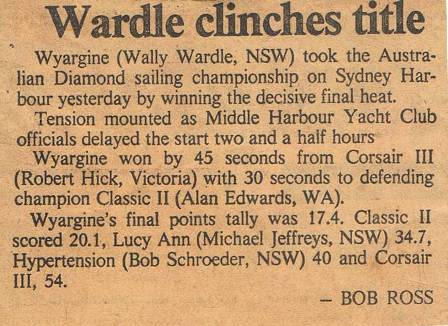 Wal was
unbeatable on Wy-ar-gine. He won the 1978 Sydney Harbour Championships
conducted by Middle Harbour Club. From 1974 on he won every race bar one, where
he came second, in the Pittwater Championship (Diamonds) at RPAYC and also won
the coveted ‘Bird Bowl’, a large bowl donated to RPAYC by
Frank Bird which held five bottles of champagne. The ritual was
the winner had to keep walking to members present offering them a sip and all
kept going until the Bird Bowl was empty. Wal was also Chairman and then elected
President of NSW Diamond Association at the 17th of June, 1977 Annual General
Meeting held at LMYC (Lake Macquaire).
Wal was
unbeatable on Wy-ar-gine. He won the 1978 Sydney Harbour Championships
conducted by Middle Harbour Club. From 1974 on he won every race bar one, where
he came second, in the Pittwater Championship (Diamonds) at RPAYC and also won
the coveted ‘Bird Bowl’, a large bowl donated to RPAYC by
Frank Bird which held five bottles of champagne. The ritual was
the winner had to keep walking to members present offering them a sip and all
kept going until the Bird Bowl was empty. Wal was also Chairman and then elected
President of NSW Diamond Association at the 17th of June, 1977 Annual General
Meeting held at LMYC (Lake Macquaire).
From a NSW Diamond Association Newsletter
issued in December 1978:
PITTWATER
FLEET.
"So you think you're a good sailor?"
Do you think you are good
enough to become the first person to beat our Wal Wardle, who over the past
three years of competitive R.P.A.Y.C. sailing has remained the conqueror of all.
(Well except one race last year when he came second.)This record, for surely no
other class has a skipper who has performed so well and so consistently,
deserves to be broken. To this end the Pittwater Fleet is offering all you
Diamond enthusiasts the chance to challenge Wal over the long week-end in
January (27th & 28th) 1979, for the Pittwater Championship and the coverted
"Bird Bowl".
Brian Jefferys.
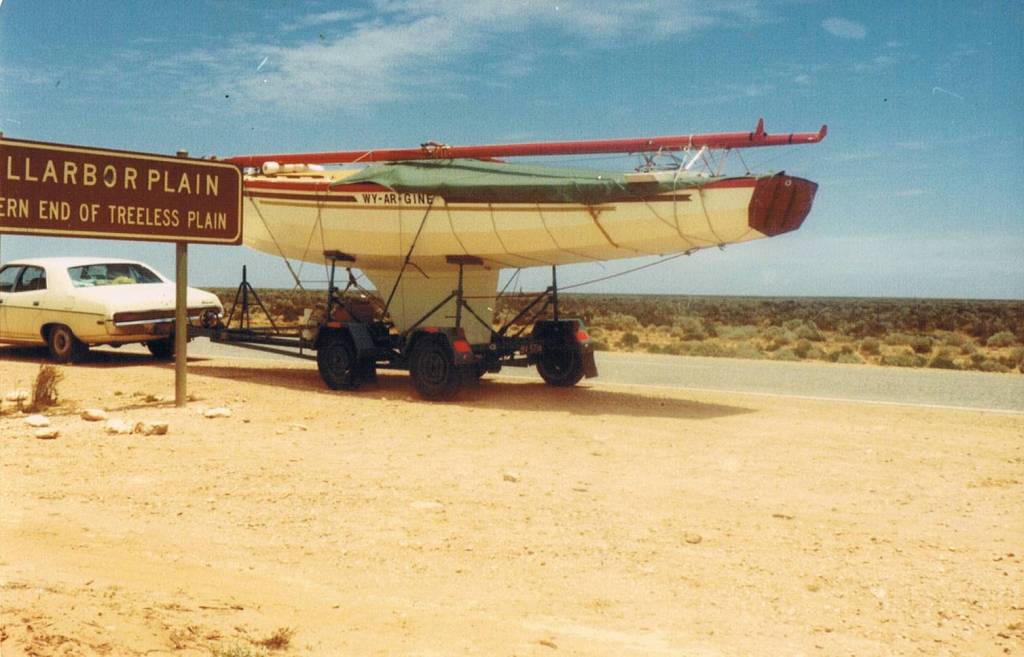
Wy-ar-gine on her way to Perth
Where did you meet Freda?
At Bathurst Teacher’s College. I went into
the Dining Room to have dinner or lunch; we used to have to bow to the official
table; we’d walk in the door, bow to the official table.
Freda; You were late. They had the grace and then the meal and if you
were late you had to apologise.
WAL: This was 1952, and I was late, and I walked down the corridor looking for a space, and I looked and I saw this girl sitting down opposite and I thought ‘I’ll marry her.’ That’s the first thing I thought ‘I’ll marry her!’ and I walked down and sat down and didn’t do anything about it until, probably the next year. We didn’t really start going out until the next year.
Was she gorgeous Wal?
Yes, she was a stunner, still is. That’s
exactly what I felt; ‘I’ll marry her.’ We got married in 1957; I was a bit slow.
Freda is celebrating her 80th on the day of our first
interview.
Wal and Freda have three daughters, some of whom Wal taught to sail.
I foolishly asked middle daughter Lyn ‘What
was the worst time you had growing up?” to which she answered ‘Dad, when you
tried to teach me to sail.”
Freda: they didn’t
like it, they just didn’t like it.
We bought a Manly Junior for them; they didn’t take to it. Their legs were dangling over the side! (laughs).
How many grandchildren?
Four.
To Freda; Did you enjoy all the years of sailing?
I didn’t mind. The family days were nice; going somewhere nice, very pleasant going to places that were quiet and beautiful.
Wal: when we took the boat to the Barrier
Reef, during the 1970’s, Freda flew there and loved it up
there.
Freda: we also took the Tammy Norrie
up there.
Yes, once we trailed the boat up there and on the way; we’d stop at caravan parks; I remember once we stopped at Rockhampton and there were floods and we couldn’t get North or South of Rockhampton. People were saying ‘can we book a seat on your boat?’; the caravan park we were in was close to being flooded.
Freda: we sailed around the Whitsunday’s in
it.
Wal: I have a good saying about the currents
in the Whitsunday’s which is true; ‘If it’s going up it’s going down – if it’s
going down it’s going up’. This is the way they flow along the coast you see,
and the tides.
Still sailing now?
Yes we sail on Lake Macquarie now whenever we can.
What was the best thing about Kalori to you? Being on Pittwater and having a yacht as part of the school to enjoy the Pittwater environment?
For me the children would get on with each other; we had something in common to talk about. We’d put King Lear aside for a bit and talk sailing for a short time. They’re still sailing as part of the curriculum at Pittwater now. You talk about the origins of sailing in Pittwater competitively as starting in 1907 and how two people just happened to challenge each other to race around Lion Island; look what it started ! That was March the 16th I think. This is the origin of the Pittwater Regatta.
Wal organised the Centenary 2007 Pittwater Regatta which showcased 18 foot skiffs in a race from and around Lion Island and back to the RMYC – Broken Bay.
Hendrik Visser’s grandfather used to come down and supervise the Kalori building…
Martin Visser, Hendrik’s father was an America’s Cup skipper at one stage, in fact he got involved in a major incident in a pre-start collision between two world leaders and became more famous for that then the good things he did; which is a shame. The grandfather, we called him ‘Oh-pa’, which was Dutch for ‘grandad’, he would come down and look at the work, look at the joints and say ‘Is not good’ or ‘Is good’ (pronounced ‘goot’); we actually learnt a lot from him about working with timber. She was built from marine plywood on a timber frame.
So how many Sydney to Hobart’s did you do?
Nine. I’m hoping to make it ten. (Don’t know when). 1968 was my first one.
What was the most memorable Sydney to Hobart for you?
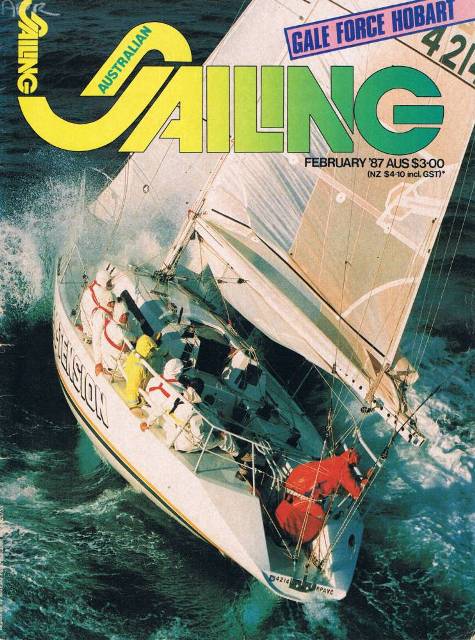 I
suppose the one we won. That was 1986 on ‘Ex-Tension’. The chap that
owned that boat, Tony Dunne, he was a builder and he did extensions; we didn’t
know whether the name meant we were meant to sail her without any stress or
whether it was ‘extension’ as an advertisement for his business. I always
remember after we’d won that race, and we’d won a few in that season, on the
Sydney Harbour. When she won the race she was a Prince Alfred boat, and a couple
years later Tony moved her down to Middle Harbour and she now appears on the
Middle Harbour Honour Board!
I
suppose the one we won. That was 1986 on ‘Ex-Tension’. The chap that
owned that boat, Tony Dunne, he was a builder and he did extensions; we didn’t
know whether the name meant we were meant to sail her without any stress or
whether it was ‘extension’ as an advertisement for his business. I always
remember after we’d won that race, and we’d won a few in that season, on the
Sydney Harbour. When she won the race she was a Prince Alfred boat, and a couple
years later Tony moved her down to Middle Harbour and she now appears on the
Middle Harbour Honour Board!
I guess later on she did become a Middle Harbour boat but when she won the Sydney to Hobart she was a Prince Alfred boat.
It was memorable because we had a very close race with a sister ship 'Queensland Maid', Johnny Isles was skipper, and we were neck and neck until we got into a storm in Bass Strait. From the middle of Bass Strait and down the coats of Tasmania is when we pulled away from her. I think it’s because we had Ian Perdriau , he’s passed away now. Ian was a very very good sailor and we reduced sail; we had a number 3 up, 3 reefs in the main; there’s a picture of us; the spray was so strong and stinging so much we were all facing inboard. Instead of having our legs over the side like you’re supposed to they were in because it was hurting so much. Ian reduced sail, whereas the other boat persevered with too much sail and then they dropped back. Or so the story goes because we didn’t see them after they dropped off. That’s what we heard.
The big shot on the front of the Yachting Magazine shows Ex-Tension; you can see the complete hull, you can see the start of the keel, and top of the rudder; she was jumping out of the water as the wind was so strong.
Freda: we’ve got a tape of it.
Wal: The background music that they’re playing is ‘Six months in a leaky boat!’
Ex-Tension, an RPAYC yacht, was winner of the 1986 AWA Sydney-Hobart yacht race. Her crew were Ian Perdriau (sailing master and navigator) Wally Wardle, Ian Treharne, Rick Coxon, Alan Walker, John Coates and Tony Clear. Her owner and skipper, Tony Dunn, commented at the time, “We went for age, not beauty”.
Ex-Tension was built by Ian Franklin in Christchurch, New Zealand. The Davidson 36 featured a big fractional rig: deep elliptical keel and rudder. Ex-Tension sailed into a winning position in a 50knot westerly gale in Bass Strait, electing not to change to storm sails but make the boat comfortable under triple-roofed mainsail and number four headsail. From Australian Sailing Magazine February, 1987
Timber vs. Fibreglass boats Wal, which is better?
The Diamond was designed to be built at home, you work off a plan and these allow for overall errors of a half inch or allow you to adjust them to make them a little longer; you see a longer waterline makes a boat quicker. With the Kalori we made her as deep as possible at the bow, a sharper bow, to increase her length. We also flattened the sections aft so there was not as much ‘u’ in them. With there being oen design it all comes down to the skill of the sailors. With fibreglass boats like you see in the Sydney to Hobart now it’s money and size that bought this result.
I remember when Swanson 36’s were allowed as a class in the Sydney to Hobart, this was great because it all came down to the skill of the crew – the best crew will win.
What is your favourite place in Pittwater and why?
On the water I’d say Towler’s Bay. Why; because in a bad southerly it’s always a sheltered quiet spot. You don’t get other boats playing loud music. The Basin as well; but often you’d find you had too much company. Up the river (Hawkesbury) at Hallett’s Beach; Portuguese Beach off Palm Beach and around the corner up to America’s Bay, all those bays were good. We’d go to different ones in our boat. Our Diamond was called ‘Wy-ar-gine’; it was originally Bob Oatley’s boat and we bought it in 1974;
My other favourite place would be Avalon Swimming pool; mainly because of the people you’d have a chat with; I’d swim there five times a week, usually every week day; and we met some lovely people, some of whom we’ve caught up with this trip, and chat away. We started going regularly soon after I retired, 1990-91. That’s one of the things I do miss; the swimming. At Lake Macquarie it is very difficult to walk into the water. The shoreline is often muddy or there’s shellfish or razor fish, which is dangerous as they are razor sharp. When I go swimming there I usually walk down a boat ramp up to my knees and then away I go. I never go in there without flippers on; you need a little bit of protection.
What is your ‘motto for life’ or a favourite phrase you try to live by?
My philosophy is ‘Do your very best then don’t worry’
But I also feel quite often people with sailing, when things go wrong with a boat, the person or people on the boat haven’t gone out and done enough training, talking to each other, and the worst thing you do is shout orders; because then the person who’s way up on the bow either won’t hear you or if they do, it might be muffled or they get upset. So you have got to be calm on a boat. We always used to think, if you see a boat over there and you can hear shouting, ‘forget them, because they won’t be a worry anymore’.
One of the things we used to do when I was sailing ‘Wy-ar-gine’ ; I’d think ‘we’re not going quite as quickly as we ought to’; (whistles thrice); just whistle and the crew will start tweaking and looking, which they do at any rate; no need to yell.
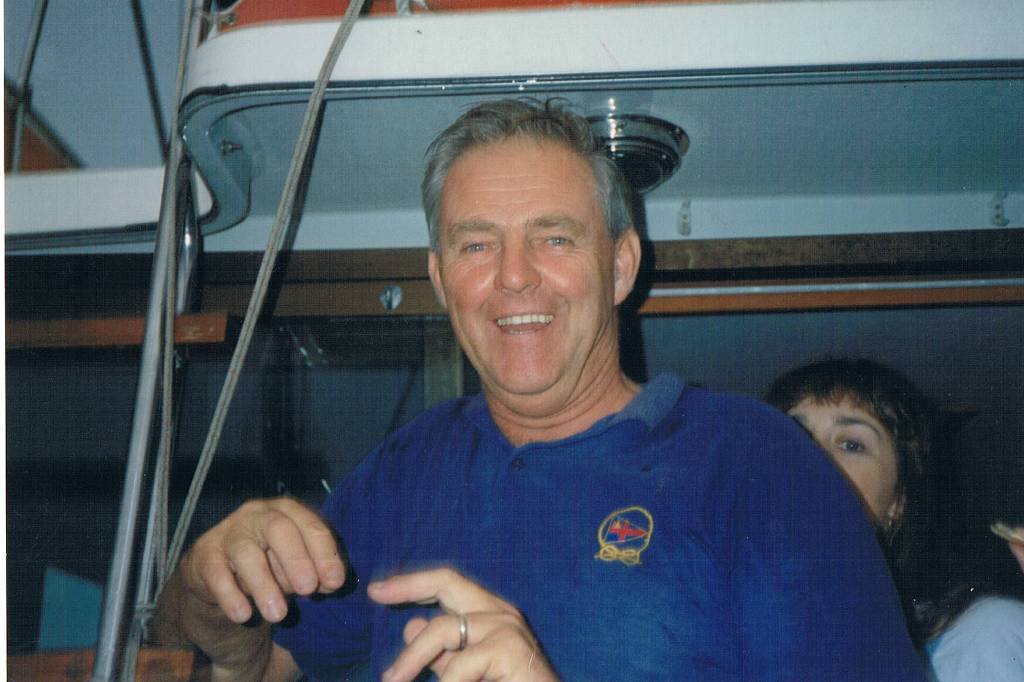
Copyright Walter Wardle, 2013. All Rights Reserved.
